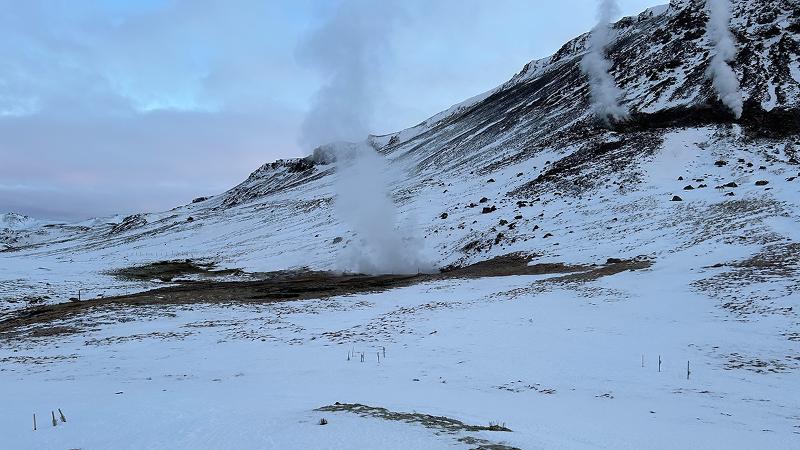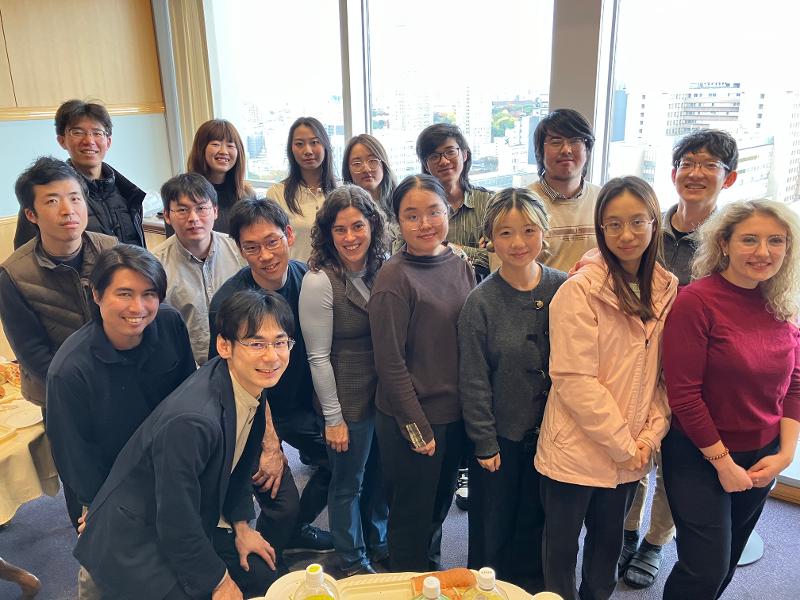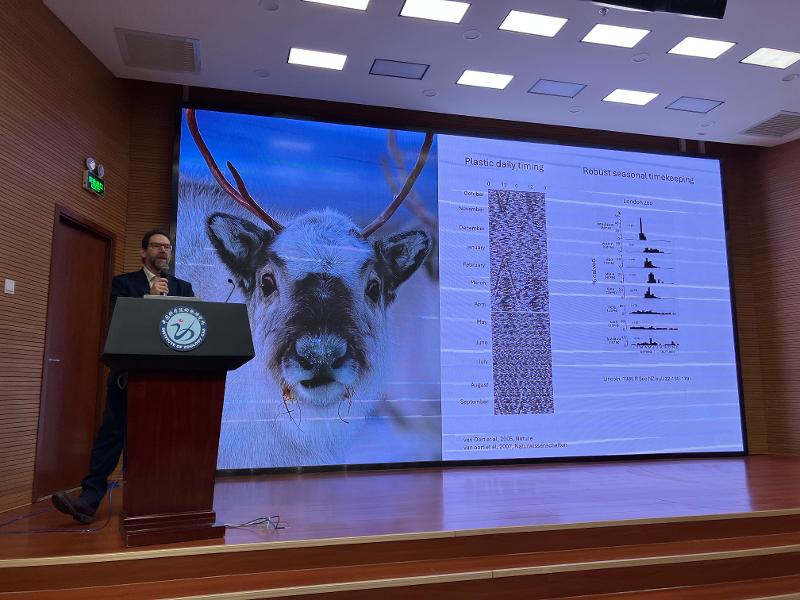People






ASTI is a capacity-building project to establish UiT as a centre of excellence for research into seasonal timekeeping mechanisms. This fills a strategic gap in chronobiology research worldwide, and is an excellent fit to UiT as the world’s northernmost research university.
ASTI will combine excellence in genome-enabled approaches to define the genetic basis of seasonal timer mechanisms (transcriptomics, comparative genomics, epigenomics, gene targeting), with state of the art approaches to in-vivo analysis of seasonal changes in physiology and behaviour (microdialysis, metabolomics, endocrinology, telemetry), and integration of complementary approaches through data processing capacity (mathematical network modelling, database management and data sharing).
ASTI will cover three overlapping themes spanning both basic and applied / societally important aspects: ‘Core seasonal timer mechanisms’, ‘Comparative seasonal chronobiology’ and ‘One seasonal health’.
ASTI will enhance awareness and understanding of the importance of seasonal timekeeping mechanisms for the health and wellbeing of humans and animals living in the Arctic region.
The centre project period is 1st April 2021 to 31st March 2025. The centre director is Professor David Hazlerigg and deputy director is Dr. Shona Wood. The centre is based within the research group Arctic chronobiology and physiology at the Department of Arctic and Marine biology.









List of key publications from 2022 -2026:
Jana Kalinová, Daniel Appenroth, Yves Bigot, Richard J. McDowell, Saba Notash, Robert J. Lucas, Alexander C. West, Shona H. Wood, Hugues Dardente, David G. Hazlerigg, Differential expression of VA opsin transcript variants in tissues linked to photoperiodic time measurement in Svalbard rock ptarmigan, Journal of Photochemistry and Photobiology, Volume 31, 2026, 100272, ISSN 2666-4690, https://doi.org/10.1016/j.jpap.2025.100272.
Wood, S.H. Perspective: rheostasis revisited—hibernation and tanycytes. J Comp Physiol B (2025). https://doi.org/10.1007/s00360-025-01636-x
West, A.C., H. Wood, S., Iversen, M. van Dalum, M.J., Jørgensen, E.H., Sandve, S.R., Hazlerigg, D.G., Photoperiodic history modulates the response of the saccus vasculosus transcriptome to seawater exposure in Atlantic salmon. J Comp Physiol A (2025). https://doi.org/10.1007/s00359-025-01779-w
Melum VJ, Bothorel B, Moralia M-A, Simmonneaux V, Hazlerigg DG, Wood SH (2025) Altered gene expression related to fuel use and sensory capacity in tanycytes throughout the hibernation season in the golden hamster. Can J Zool 103: 1-13 https://doi.org/10.1139/cjz-2024-0180
Ciccone C, Dötterer SE, Jensen SV, Geβner C, West AC, Wood SH, Hazlerigg DG, Folkow LP (2025) Potential for flexible lactate shuttling between astrocytes and neurons to mitigate against diving-induced hypoxia. Front Neuroanat 19: 1607396 https://doi.org/10.3389/fnana.2025.1607396
Gjerde B, Boison SA, Hazlerigg D, Ytrestøyl T, Mørkøre T, Jørgensen E, Striberny A and Sandve SR (2025) Impact of three light smoltification regimes on the performance and genetic parameters of traits in Atlantic salmon. Front. Anim. Sci. 6:1615804. doi: 10.3389/fanim.2025.1615804
Kalinová, J., Appenroth, D., Cázarez-Márquez, F. Thorvaldsen, R., Hazlerigg, D.G., Nymo, I.H., Anesthetic and analgesic management of Svalbard rock ptarmigan (Lagopus muta hyperborea) undergoing experimental stereotaxic neurosurgery. BMC Vet Res 21, 638 (2025). https://doi.org/10.1186/s12917-025-05082-3
Butler TD, Downton P, Dickson SH, Luengas-Martinez A, Simpkins DA, Khoo I, Veal S, West AC, Adamson A, Bechtold DA, McLaughlin JT, Gibbs JE (2025) Colonic unflammation modulates the intestinal landcape. iScience 28: 113183 https://doi.org/10.1016/j.isci.2025.113183
Nymo IH, Bøe CA, Romano JS, Lian H, Thorvaldsen R, Suhel F Boye M, Øines Ø, Folkow LP, Solvang HA, Jinnerot T, Wensman JJ, Davidson RK, Mørk T, Olsen L, Tryland M, Rockström U, Spilsberg B (2025) First detection of a cervidpoxvirus in Europe – disease occurrence in semi-domesticated Eurasian tundra reindeer (Rangifer tarandus tarandus) in Norway and Sweden. Microbiology Spectrum 13 (7): e02296-24 https://doi.org/10.1128/spectrum.02296-24
Postel A, Gremmel N, Lydersen C, Kovacs KM, Schick LA, Siebert U, Nymo IH, Becher P (2025) Highly pathogenic avian influenza virus (H5N5) detected in an Atlantic walrus (Odobenus rosmarus rosmarus) in the Svalbard Archipelago, Norway, 2023. Emerging Microbes & Infections 14: 2456146 https://doi.org/10.1080/22221751.2025.2456146
Josefsen TD, Mørk T, Nymo IH, Romano JS, Tryland M (2025) Prevalence and density of Elaphostrongylus rangiferi larvae in faecal samples of semi-domestic reindeer (Rangifer tarandus tarandus) in Norway 2013-16. Acta Vet Scand 67:5 https://doi.org/10.1186/s13028-025-00793-x
Frøvoll TL, Lybeck K, Lund H, Makvandi-Nejad S, Grimholt U, das Neves CG, Tryland M, Nymo IH, Klevar S (2025) Measuring cytokines in Eurasian tundra reindeer (Rangifer tarandus tarandus) with a bovine bead-based multiplex immunoassay and real-time PCR. Acta Vet Scand 67: 34 https://doi.org/10.1186/s13028-025-00819-4
Tomotani, B.M., Couweleers, M., ten Brinke, B., Walboom A., van Oers, K., Visser, M.E. 2025., Size in the city: morphological differences between city and forest great tits have a genetic basis Evolution Letters: qraf006.
Visser M.E., van Oers K., Charmantier A., Drobniak S.M., Jones C.V., Mathyssen E., Rowe M., Tomotani B.M. 2025. Geographic differences in the phenology of gonadal development and moult, but not of egg laying, are genetically based in a small songbird Proc. R. Soc.B. 292: 20242286.
Salvador, R.B. & Tomotani, B.M. Clocks at a snail pace: biological rhythms in terrestrial gastropods. PeerJ 12:e18318.
Pasqualina Gaetano, Vilma Duarte, Anja Striberny, David G. Hazlerigg, Even H. Jørgensen, Marco A. Campinho, Juan Fuentes (2025) Molecular responses in the intestine of Atlantic salmon (Salmo salar) following light and diet stimulation of smoltification: Potential molecular markers for a seawater-ready smolt, Aquaculture, 596, Part 1, https://doi.org/10.1016/j.aquaculture.2024.741742
, , , , , , , , , & (2024). Transcriptomic profiling of gill biopsies to define predictive markers for seawater survival in farmed Atlantic salmon. Journal of Fish Biology, 1–9. https://doi.org/10.1111/jfb.16025
Appenroth D, Ravuri CS, Torppa SK, Wood SH, Hazlerigg DG, West AC. The Reindeer Circadian Clock Is Rhythmic and Temperature-compensated But Shows Evidence of Weak Coupling Between the Secondary and Core Molecular Clock Loops. Journal of Biological Rhythms. 2024;39(6):554-567. doi:10.1177/07487304241283066
, , , & (2024). Vision at high latitudes: High sensitivity without specific boreal adaptations in photoreception in reindeer (Rangifer tarandus L.). Functional Ecology, 00, 1–15. https://doi.org/10.1111/1365-2435.14669
Daniel Appenroth, Alexander C West, Shona H Wood, David G Hazlerigg (2024), Tanycytes from a bird’s eye view: gene expression profiling of the tanycytic region under different seasonal states in the Svalbard ptarmigan, Journal of Comparative Physiology A, 1-13, https://doi.org/10.1007/s00359-024-01716-3
Barbara M. Tomotani, Aurelia F. T. Strauß, Dmitry Kishkinev, Huib van de Haar, Barbara Helm (2024), Circadian clock period length is not consistently linked to chronotype in a wild songbird, European Journal of Neuroscience, https://doi.org/10.1111/ejn.16535
Tennyson, A.J.D.; Salvador, R.B.; Tomotani, B.M.; Marx, F.G. A New Diving Pliocene Ardenna Shearwater (Aves: Procellariidae) from New Zealand. (2024). Taxonomy, 4(2), 237-249.
David G Hazlerigg, Valérie Simonneaux, Hugues Dardente (2024), Melatonin and Seasonal Synchrony in Mammals Journal of Pineal Research 76(5)e12996 https://doi.org/10.1111/jpi.12996
Fredrik AF Markussen, Fernando Cázarez-Marquez, Vebjørn J Melum, David Hazlerigg, Shona Wood, c-fos induction in the choroid plexus, tanycytes and pars tuberalis is an early indicator of spontaneous arousal from torpor in a deep hibernator, Journal of Experimental Biology, 227(10), 2024, https://doi.org/10.1242/jeb.247224
Melum VJ, de Miera CS, Markussen FAF, Simonneaux V, Hazlerigg DG, Wood SH (2024) Hypothalamic tanycytes as mediators of maternally programmed seasonal plasticity. Current Biol 34: 1-9 https://doi.org/10.1016/j.cub.2023.12.042
Chen J, Wu W, Long J, Liu X, Hazlerigg D, Zhan X. The circannual clock: Empowering seasonal anticipation in organisms. Sci Bull (Beijing). 2024 Jun 30;69(12):1839-1843. doi: 10.1016/j.scib.2024.02.018. Epub 2024 Feb 12. PMID: 38402031.
Ciccone C, Kante F, Folkow LP, Hazlerigg DG, West AC, Wood SH (2024) Circadian coupling of mitochondria in a deep-diving mammal. J Exp Biol (2024) 227 (7): jeb246990. https://doi.org/10.1242/jeb.246990
Tyler NJC, Post E, Hazlerigg DG (2024) Weak coupling between energetic status and the timing of reproduction in an Arctic ungulate. Sci Rep 14: 6352 https://doi.org/10.1038/s41598-024-56550-z
David G. HazleriggDaniel AppenrothBarbara M. TomotaniAlexander C. WestShona H. Wood; Biological timekeeping in polar environments: lessons from terrestrial vertebrates. J Exp Biol 1 December 2023; 226 (23): jeb246308. doi: https://doi.org/10.1242/jeb.246308
van Dalum MJ, van Rosmalen L, Appenroth D, Fernando Cazarez Marquez, Renzo Roodenrijis, Lauren De Wit, Roelof Hut, David Hazlerigg, Ambient Temperature Effects on the Spring and Autumn Somatic Growth Trajectory Show Plasticity in the Photoneuroendocrine Response Pathway in the Tundra Vole. Journal of Biological Rhythms. 2023;0(0). doi:10.1177/07487304231190156
Tomotani Barbara M., Timpen Fabian and Spoelstra Kamiel, 2023 Ingrained city rhythms: flexible activity timing but more persistent circadian pace in urban birds Proc. R. Soc. B.2902022260520222605 http://doi.org/10.1098/rspb.2022.2605
Melanie Lindner, Jip JC Ramakers, Irene Verhagen, Barbara M Tomotani, Christa Mateman, PhillipGienapp, Marcel E Visser, Genotypes selected for early and late avian lay date differ in their phenotype, but not fitness, in the wild.Sci. Adv.9,eade6350(2023).DOI:10.1126/sciadv.ade6350
Nord, A., Holje, V., Judik, B. Folkow, L.P, Pap, P.L. Seasonal changes in plumage density, plumage mass, and feather morphology in the world’s northernmost land bird, the Svalbard Rock Ptarmigan (Lagopus muta hyperborea). Polar Biol 46, 277–290 (2023). https://doi.org/10.1007/s00300-023-03118-8
Pasqualina Gaetano, Vilma Duarte, Anja Striberny, David Hazlerigg, Even H. Jørgensen, Marco A. Campinho, Juan Fuentes, Photoperiod and dietary treatment in freshwater modulate the short-term intestinal response to seawater in Atlantic salmon (Salmo salar), Aquaculture, 568, 2023, 739316, https://doi.org/10.1016/j.aquaculture.2023.739316.
List of key publications from 2020 -2022:
Vilma Duarte, Pasqualina Gaetano, Anja Striberny, David Hazlerigg, Even H. Jørgensen, Juan Fuentes, Marco A. Campinho, Modulation of intestinal growth and differentiation by photoperiod and dietary treatment during smoltification in Atlantic salmon (Salmo salar, L.), Aquaculture, 566, 2023, 739164, https://doi.org/10.1016/j.aquaculture.2022.739164
Gundappa MK, To TH, Grønvold L, Martin SAM, Lien S, Geist J, Hazlerigg D, Sandve SR, Macqueen DJ. Genome-wide reconstruction of rediploidization following autopolyploidization across one hundred million years of salmonid evolution. Mol Biol Evol. 2021 Oct 28:msab310. doi: 10.1093/molbev/msab310.
Francis J. P. Ebling, John Fletcher, David G. Hazlerigg, Andrew S. I. Loudon, Gerald Lincoln: A man for all seasons Journal of Neuroendocrinology, e12968
Daniel Appenroth, Gabriela C.Wagner, David G.Hazlerigg, Alexander C. West, Evidence for circadian-based photoperiodic timekeeping in Svalbard ptarmigan, the northernmost resident bird Current Biology, https://doi.org/10.1016/j.cub.2021.04.009
Laura van Rosmalen, Jayme van Dalum, Daniel Appenroth, Renzo T. M. Roodenrijs, Lauren de Wit, David G. Hazlerigg, Roelof A. Hut, Mechanisms of temperature modulation in mammalian seasonal timing The FASEB JournalVolume 35, Issue 5 e21605
West, Mizoro, Wood, Ince, Iversen, Jørgensen, Nome, Sandve, Martin, Loudon and Hazlerigg, Immunologic profiling of the Atlantic salmon gill by single nuclei transcriptomics, Front. Immunol. 2021
Marianne Iversen, Teshome Mulugeta, Alexander C West, Even H Jørgensen, Samuel A M Martin, Simen Rød Sandve, David Hazlerigg, Photoperiod-dependent developmental reprogramming of the transcriptional response to seawater entry in Atlantic salmon (Salmo salar), G3 Genes|Genomes|Genetics, Volume 11, Issue 4, April 2021, jkab072,
Appenroth, D. Nord, A., Hazlerigg, DG. Wagner, GC. Body Temperature and Activity Rhythms Under Different Photoperiods in High Arctic Svalbard ptarmigan ( Lagopus muta hyperborea) Front. Physiol. 2021, 12:633866
- An up-to-date and authoritative textbook explaining the mechanisms by which biological rhythms affect physiology and behaviour major contributions from key members of ASTI: Shona Wood, David Hazlerigg and Alex West
Markussen, F.A., Melum, V.J., Bothorel, B. et al. A refined method to monitor arousal from hibernation in the European hamster. BMC Vet Res 17, 14 (2021). https://doi.org/10.1186/s12917-020-02723-7
Striberny, A., (...) Hazlerigg, D.G., Jørgensen, E.H., Author links open overlay panelStriberny, A., … Hazlerigg, D.G, Jørgensen, E.H.Striberny, A., … Hazlerigg, D.G, Jørgensen, E.More than one way to smoltify a salmon? Effects of dietary and light treatment on smolt development and seawater growth performance in Atlantic salmon. Aquaculture 532, 15 (2021), 736044 (2021). https://doi.org/10.1016/j.aquaculture.2020.736044
, , ,
https://doi.org/10.1371/journal.pone.0227496
, Photoperiodic regulation in a wild-derived mouse strain
Photoperiodic history modulates the response of the saccus vasculosus transcriptome to seawater exposure in Atlantic salmon
, , , , , , , , Metatranscriptomic Insights into Microbial Dynamics Prior to Disease Onset in Atlantic Salmon Aquaculture
Impact of three light smoltification regimes on performance and genetic parameters of traits in Atlantic salmon, Bjarne Gjerde, Solomon Antwi Boison, David Hazlerigg, Trine Ytrestøyl, Turid Mørkøre, Even Jørgensen, Anja Striberny, Simen Rød Sandve
doi: https://doi.org/10.1101/2024.04.02.587721
Weak influence of light and time of day on transcriptional response to SAV3 infection in Atlantic salmon (Salmo salar) smolts, Therese Solberg, Chandra S Ravuri, Mattis Jayme van Dalum, Jo Espen Tau Strand, David G Hazlerigg, Eva Stina Edholm, Alexander C West
doi: https://doi.org/10.1101/2024.06.14.599015
Roelof Hut, University of Groningen
Stafford Lightman, University of Bristol
Kelly Drew, University of Alaska, Fairbanks